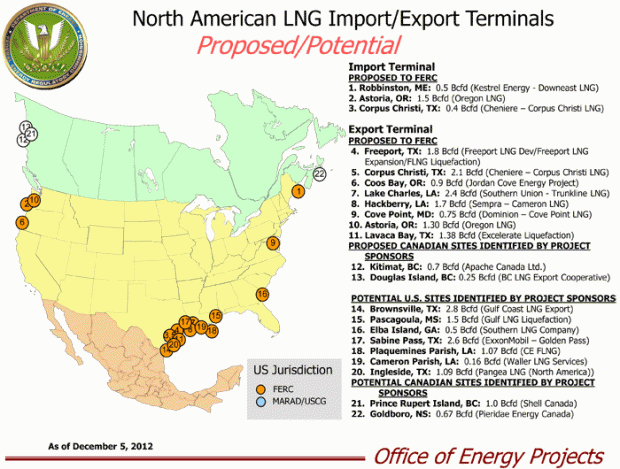Under New Approval, More Natural Gas Will Be Sent Abroad From Texas
As a drilling boom continues in Texas and other states, the U.S. finds itself with so much natural gas that some companies now want to export domestic fuels abroad.
Today, the federal Department of Energy (DOE) announced approval of a second facility, the Freeport LNG Terminal on Quintana Island, to export natural gas in liquid form to countries not party to free trade agreements with the U.S. That would mean that gas-hungry markets like Japan could start buying natural gas from Texas ports at much higher rates than domestic consumers.
In an interesting twist, many of these facilities for exporting natural gas already exist: they were built in recent years to import natural gas from other countries, before a fracking boom unlocked domestic supplies. The Freeport terminal only started construction in 2005. By the time it was up and running in 2008 to import natural gas, the fossil fuel balance in the U.S. had started to turn upside down. Now there’s a rush to undergo an expensive (roughly $5 billion per plant) conversion at these plants to send gas out instead of bring it in.
Generally, drilling companies have supported the move to export natural gas. A glut of gas (and a warm winter in 2011-2012) led to low natural gas prices. Exports could potentially raise those prices, which has some domestic manufacturers opposing the moves towards exports. As manufacturers often use natural gas as a feedstock, they worry that exports will result in higher prices.
There are environmental concerns as well. As Dave Fehling reported for us in January:
Among the [Sierra Club’s] concerns is whether regulators have fully considered how liquified natural gas (LNG) exports might further increase the drilling process called fracking.
“You’re looking at hundreds or thousands of new wells depending on how much gas you’re exporting. And you’re looking at a big spike in production,” Craig Segall, an attorney for the Sierra Club, told StateImpact Texas. ”If we ultimately do make the choice that we should be gas exporters rather than exporters of finished goods or industrial products we better be pretty sure we can produce that gas safely. And we just aren’t there.”
Earlier, the Freeport facility had been approved for countries that already have free trade agreements with the U.S.
Once an environmental review is conducted and the project gets final approval, the Freeport Quintana facility could export up to 1.4 billion cubic feet of natural gas a day over twenty years.
This is the second time a natural gas export facility has been approved by the federal government for sales to countries not in free trade agreements with the U.S. Another project already approved is in Cameron Parish, Louisiana, approved to export up to 2.2 billion cubic feet of natural gas a day. Combined, that would represent roughly 5 percent of the country’s daily natural gas production, according to the U.S. Energy Information Administration.
For the drilling industry, that may not even be as much as they’d like. In an emailed statement today, Marty Durbin, President and Chief Executive Officer for America’s Natural Gas Alliance (ANGA), a drilling lobbying group, said that while today’s announcement is a “positive step,” his group “would like for the administration to pick up the pace of approvals so that the markets can decide which projects go forward.”
The Department of Energy says they’ll consider other gas export proposals on a “case-by-case basis.”



